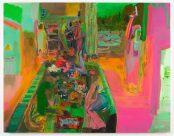[dropcap style=”font-size:100px; color:#992211;”]D[/dropcap]ealing with ‘crap’ to improve water quality.
I think the idea ‘came’ to Marcus because he wanted to ‘experiment’ but the girls said no.
Former UC Riverside student builds replica human colon and feeds it three times per day to understand impact bacteria has on groundwater.
To better understand how bacteria impact the environment a former University of California, Riverside graduate student spent nearly a year building a system that replicates a human colon, septic tank and groundwater and “fed” the colon three times a day during weeklong experiments to simulate human eating.
Ian Marcus, who recently earned his Ph.D. from the UC Riverside Bourns College of Engineering, said discussion of the research often left people a bit perplexed.
A Perfect Robot Arse
“People would give a kind-of-interested-but-definitely-don’t-talk-about-it-during-dinner look because we’re literally dealing with crap,” Marcus said. “It has got the smell. It has got everything.”
The idea for the project came after Marcus noticed that scientists typically study bacteria in an isolated environment under ideal growing conditions. That presents a problem because bacteria typically proliferate in microbial communities with other microorganisms such as archaea, fungi and protozoa.
Marcus set out to solve that problem by creating a simulated environment where the life cycle of bacteria (he used a pathogenic strain of E. coli in these experiments) and the microbial communities they live in can be studied from the human colon to water treatment to groundwater.
In the past, researchers have simulated the gut of humans and synthetic aquatic environments, but no one had combined the two, as far as Marcus can tell.
By comparing his finding with those of researchers who worked with bacteria in an isolated environment, Marcus found that the E. coli strain in the microbial community may be less mobile in aquatic environments and more prone to biofilm that than the isolated strain.
This means that the E. coli would linger longer in the environment, since biofilm provides a refuge for all the microorganisms within it. When the biofilm matures it sends out bacteria to colonize another surface thus the bacteria could survive in the environment for longer periods of time.
Robot Arse Leads to Science Alliteration Shocker
“This means that pathogens could potentially linger longer and over a long period of time travel greater distances in the groundwater,” Marcus said.
Marcus said his research shows you should study microorganisms as close to possible in their natural habitats.
Marcus, who worked in the lab of Sharon Walker, an associate professor of chemical and environmental engineering, had his findings published in a paper called “Linking Microbial Community Structure to Function in Representative Simulated Systems” in the journal Applied Environmental Microbiology. Co-authors were Walker, and Hailey A. Wilder and Shanin J. Quazi, both former students in Walker’s lab.
“It is a pleasure to work with a student who can think outside of the box and bring in fresh ideas on how we can approach our research,” Walker said. “Ian’s work has provided critical new insight into how microbial communities behave in wastewater treatment and contribute to biological contamination of water, which really changes the paradigm of how we do research and manage our water resources.”
Source: University of California – Riverside. Eurekalert.
Image: Freedigitalphotos.net/Sommai

Some of the news that we find inspiring, diverting, wrong or so very right.




















